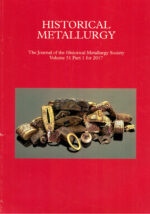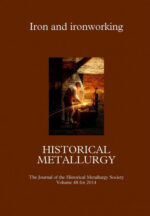Journal Contents
Visigothic filigree in the Guarrazar (Toledo) and Torredonjimeno (Jaen) treasures
Alicia Perea
Pages 1-11
The Guarrazar treasure is a group of Visigothic votive crowns and crosses found in 1858. A second treasure was found at Torredonjimeno in 1926, and both of them are now scattered in Spanish and French institutions in Madrid, Barcelona, Cordoba and Paris. The Guarrazar objects are better preserved, with the complete crown and cross of King Reccesvinthus as its highlight, although a large part was destroyed or lost. In contrast, the Torredonjimeno treasure is a huge quantity of highly fragmented crowns and crosses. It is the biggest group of Visigothic jewellery in Europe, which is very scarce and poorly studied. This paper discusses only a small part of the Visigothic jeweller’s skill, that related to filigree work. Visigothic craftsmanship should not be considered as medieval, but as the last manifestation of the technology of antiquity.
Back to Front: Observations on the development and production of decorated backing foils for garnet cloisonne
Noël Adams
Pages 12-26
Scientific analysis and discussion of the reflective metal foils set behind garnet inlays has concentrated on waffle-patterned foils produced in the late 6th and 7th centuries AD. This paper examines 5th-century AD waffle, ring-and-dot and rare feather-patterned foils which may derive from the decorative repertoire of late Roman gold and silver working. The production of the multiple inlay elements characteristic of garnet cloisonné, however, demanded a more rapid means of fabrication. Current theories regarding the manufacture of cloisonné backing foils are reconsidered in the light of the varied appearance of actual foils and the technological capability that might be expected of an early medieval workshop. Experiments in producing primary models suggest that textiles or thread could be used to impress clay with grids for waffle and ring-and-dot foils. These clay models could have been used on their own or for casting positive or negative dies in copper alloy.
Technological aspects of the Viking age gold treasure from Hiddensee, Germany
Barbara Armbruster with H Eilbracht
Pages 27-41
This paper deals with the study of ancient gold jewellery manufacture, in particular the techniques and tools used during the Viking age. It discusses the Hiddenseestyle, named after the gold hoard found at the end of the 19th century on the shores of Hiddensee. This kind of jewellery is generally dated to the 10th and early 11th century AD, when Christianization of the north is beginning. It is characterized by a hollow body made of thin gold sheet with a typical relief decorated with filigree and granulation. The hoard also contains a twisted neck ring, made of several harnmered rods and a clasp. Twisted neck and arm rings were in fashion in the Viking world and also with the Slavs, their eastern neighbours, and were worn during the entire Viking period, fi-om about 800-1050 AD.
All that glitters: the case for goldworking at the early medieval monastery at Portmahomack
Cecily A Spall
Pages 42-48
Excavation of the early medieval workshops at the Pictish monastic site at Portmahomack, Ross-shire, has revealed evidence for a range of crafts being practised, dated provisionally to the 7th to 9th century. The crafts of the smith (including glassworking), leather- and wood-workers are recognisable from discarded tools, and raw andwaste (including failed) products, recovered mostly from features, floor layers and dumps within the main craft-working zone. The working of copper alloys and silver, signalled initially by crucibles, has been confirmed by a programme of XRF analysis, but to date evidence for goldworking at the site remains elusive. The possibility of early medieval gold-smithing at Portmahomack is examined and discussed in the context of the Tarbat workshops and evidence from contemporary sites in Britain.
The Cross of Cong and some aspects of goldsmithing in pre-Norman Ireland
Griffin Murray
Pages 49-67
The Cross of Cong is the most important reliquary surviving from early medieval Ireland and belongs to a large corpus of pre-Norman, decorative, church metalwork from the late 11th and 12th centuries. The materials and techniques behind the manufacture of this most impressive piece of metalwork are examined. Reviewing the historical and archaeological evidence for goldsmithing in Ireland during this period identifies gaps in current knowledge about this craft. Sources of raw materials, whether native or imported, are also discussed, with a particular emphasis on the source and availability of gold. Finally, by examining the Cross in some detail, the range of techniques practised by goldsmiths in Ireland in the period c1050-c1150 can be appreciated.
On the Noble and Illustrious Art of the Goldsmith: an 11th-century text
Jochem Welters
Pages 68-
The 11th-century Greek manuscript, On the Noble and Illustrious Art of the Goldsmith, is characterised by an unusual equality in the treatment of recipes and technical procedures. In spite of its similarities to late classical and early medieval traditions of artistic-technical writings, the tract demonstrates a great deal of independence in that it describes many methods and uses of materials for the first time, and was the only reference in some cases. These include: gold plating by welding, applying niello with all the necessary steps, enamelling, etching of metals, refining gold with antimony, and making filigree. The commentary explains the substances and procedures, and outlines the status of the individual recipes within historical tradition through comparison with both earlier and later sources.






ellieadmin –
One of my favorite journal volumes with loads of great articles on the Early Medieval precious metalworkers.